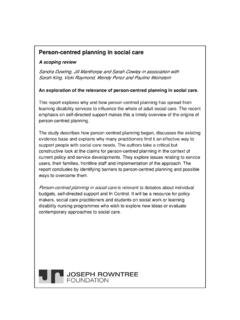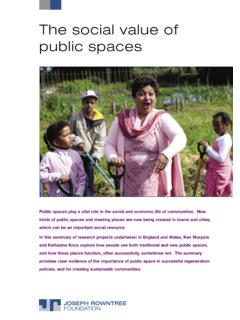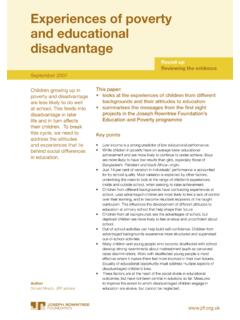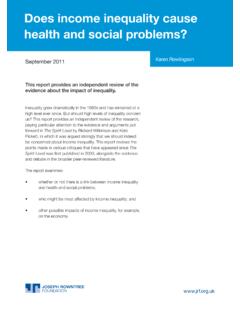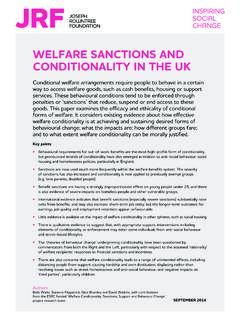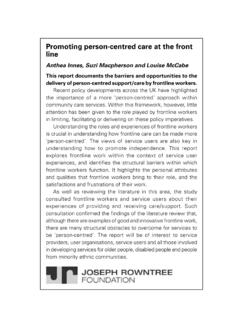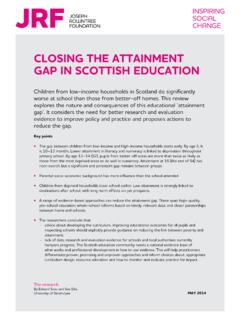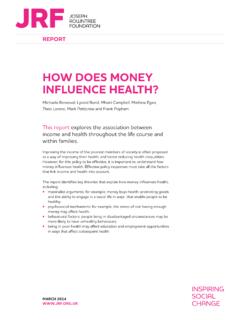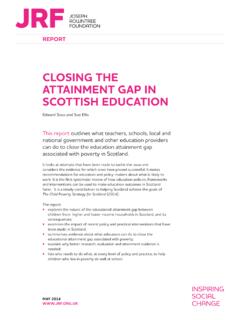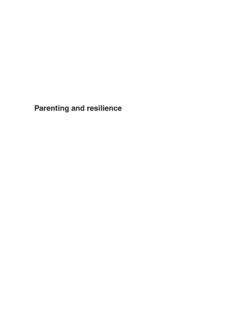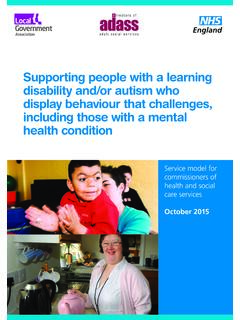Transcription of Towards a social model of madness and distress? Exploring ...
1 A social model of madness and distress ? Exploring what service users sayPeter Beresford, Mary Nettle and Rebecca PerringNovember 2010 This report explores mental health service users views about social approaches to madness and mental distress and their relationship with the social model of a time when there is growing interest in recovery in mental health policy and practice, service users highlight that a medical model still dominates public and professional understanding. They largely see this as damaging and unhelpful. They see social approaches to mental health issues as much more helpful. At the same time, their views about the social model of disability are complex. There is no the report, a wide range of service users look at: how mental health issues are understood in society; people s personal understandings of mental health issues; the social model of disability in relation to mental health; a possible social model of madness and and stigma following from a medical model of mental illness emerge as major barriers for mental health service users.
2 The repor t highlights the impor tance of developing discussion about social approaches to mental health among service users, professionals, policy-makers and the public, to improve understanding, policy and 4 List of tables 6 Executive summary 7 Introduction 101 How mental health issues are understood in society 132 People s personal understandings of mental health issues 163 The social model of disability in relation to mental health 194 Exploring a social model of madness and distress 215 Conclusion 296 Recommendations 31 Reading material 34 Appendix I: How we carried out the study 36 Appendix II: Schedule for interviews and group discussions 40 Acknowledgements and About the authors 454 ForewordsI was very excited when I fi rst heard that this piece of work, led by mental health service users/survivors, was being undertaken.
3 As far as I was concerned, it was long overdue. This study is important for many reasons. It could be argued that the mental health service user/survivor movement and that of the wider disabled people s movement have been, and are, for the most part carving their own paths ahead. Also, in recent times, some key government documents that the disabled people s movement has helped shape seem to have passed mental health users/survivors by. If we as mental health service users/survivors joined forces more closely with our disability colleagues, we would help each other to infl uence the strategic debates, and make sure users/survivors don t miss out. A crucial and defi ning factor in this project is that it is led by survivor researchers. This, to me, is the only way that service users/survivors can highlight what we consider important to ask.
4 Moreover, the report uses many of the personal narratives given by those users/survivors and disabled people to help bring the issues to life, to the extent that it is actually co-written by those taking par t. This is true power sharing. The medical model is such a dominant way of viewing our lives that it does not allow for other discussion, and therefore consigns the ill person to a negative outlook on life, which is mirrored by society s reaction to us. We will contend that how conditions those that we have, or those that surround us affect us is far more complex than how the medical model expresses it. Views on this can be found within this report. Also, there is no consensus around the terminology of what we or others call us. Language is contextual and can be ver y power ful in how it is used. Why is so much of the mainstream language to describe disability and mental ill health so negative, when it could be so liberating?
5 I hope that this research helps to bring the mental health user/survivor movement closer together with our disability colleagues. We have so much in common, often sadly through the oppression we all experience. However, we also have much to learn from one another in the form of user-led ideas, campaigns and successful projects that help shape a brighter future for us all. There is still much work to do, but this report helps light a fi re under the debate that needs to crackle and roar, and I suspect will not go out for some while yet. We all have a collective responsibility to move forward the ideas and recommendations within the report, and I look forward to working with you on ColdhamChair, National Survivor User its formulation in the early 1980s, the social model of disability has had a considerable impact on public policy, disability politics and disabled people s own understandings of their positions in society.
6 It has also provoked considerable controversy and confl ict over its appropriateness and application. This has resulted in it being stretched beyond the parameters of its initial formulation, which was as a tool for producing social change, into a comprehensive explanation for the disabling society. As a consequence, in recent years too much time has been spent in heated academic and personal debates about its relevance and usefulness and not enough in applying it to the real life circumstances of disabled people. This report is therefore to be welcomed because it takes seriously the need to examine the social model s usefulness based on lived experience and does not regurgitate yet more arguments about the need to abandon or modify it. In asking pertinent questions about how it might be used to change the lives of a group of people who use mental health services, it goes into an area where little work has been done so far.
7 In so doing it raises the controversial question of where impairment fi ts into the social model ; it also demonstrates that most of the people interviewed brought with them a social understanding of their own circumstances and that for a considerable number of these participants this had been informed by the social model of disability . The key dilemma the report raises is whether a distinct and separate model of madness and distress is needed or whether the issues and concerns of mental health service users can be incorporated and utilised within the social model of disability . Clearly, this is a key issue for the politics of mental health in particular and disability politics more generally. All those who continue to talk about the social model rather than use it would do well to read this repor t, as it shines as a beacon for fur ther attempts to generate social OliverEmeritus Professor of disability StudiesUniversity of Greenwich6 List of tablesTables1 Category of service user 382 Gender 383 Personal identifi cation by ethnicity 394 Participants identifi cation by age group 39 List of tables7 Executive summaryThis report offers the fi ndings from a two-year user-controlled national study Exploring the idea of a social model of madness and distress and its relationship with the social model of disability .
8 It is primarily based on the views of a wide range of mental health service users. Four key issues were explored with participants:1. How mental health issues are understood in Their personal understandings of mental health The social model of disability in relation to mental Their personal understandings of madness and distress within a social model of number of key fi ndings emerge from the project. These include that: There is signifi cant agreement that the existing dominant medicalised individual model of mental illness is negative in ef fect; This medical model is seen as very powerful among professionals, in society generally and also among service users, shaping understanding and attitudes; Service users views about the social model of disability (with which most were familiar) are complex and varied; At the same time there is strong support for more social approaches to understanding and responding to mental health issues.
9 People feel that broader issues need to be taken more account of to counter the individualisation of mental health issues; Most participants feel that, as mental health service users, they experience barriers in the same way that disabled people have highlighted the barriers restricting them; There is no consensus about terminology in this fi eld among service users. This relates to the negative associations of most of the terminology in use. This creates signifi cant barriers and problems in the way of advancing thinking and action Towards different understandings of mental health issues. These should not, however, be seen as an insuperable obstacle, as a lively and diverse service user/survivor movement has developed; Some service users can see real gains in developing new ways of thinking about mental health issues, building on a social model of disability .
10 They see this as encouraging greater unity and shared understanding among different groups of service users and a conceptual framework more suited to valued approaches to personal and social suppor t; Executive summary8 Executive summary However, some service users also offer challenges to some existing understandings of a social model of disability and some other service users see the framework of a social model of disability as less helpful; A particular issue that creates concerns for people is the concept of impairment as part of the social model of disability . Some mental health service users feel that they and other mental health service users may not have an impairment and that it may therefore be unhelpful to apply this idea to them; This prompted some service users to think that more thought was needed about the social model of disability , a possible social model of madness and distress and the relation there might be between the fi ndings provide the basis for a series of recommendations, which are mainly concerned with sharing and developing discussion around social understandings of mental health issues that will help in taking forward the current emphasis on advancing independent living and a rights-based approach to increasing the life chances of all disabled people, including mental health service users.
